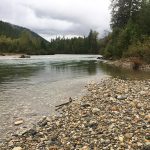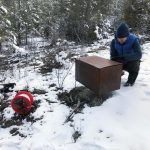Flathead River Biomonitoring Program Summary Report now available
The Flathead River is a trans-boundary tributary of the Columbia River, flowing from the Canadian Rocky Mountains south into Montana. This system is significant because it includes the headwaters of three extensive continental river systems (Columbia, Missouri/Mississippi, and Saskatchewan). The Flathead River watershed is known for supporting habitat connectivity, extremely high terrestrial biodiversity, and diverse aquatic life.
“The Flathead is unique as an unsettled river valley that supports robust populations of Westslope cutthroat trout, bull trout and iconic wildlife species, making it an important watershed for fish and wildlife connectivity, and for ensuring overall resilience to climate change in the Canadian Southern Rockies,” said Flathead Lake Biological Station Senior Scientist Erin Sexton with the University of Montana.
Because of its remote location and lack of other human developments, the Canadian Flathead watershed offers a unique opportunity to observe the isolated effects of timber harvest practices on aquatic health.
This observation was the intent of the Flathead River Biomonitoring Program, a five-year project that took place between 2013 and 2017. The project examined the aquatic health of five different sub-basins — one of which had no previous logging activity — to observe any effects over the five-year period. The recently published Flathead River Biomonitoring Program Summary Report outlines the results from these efforts.
Using the Canadian Aquatic Biomonitoring Network (CABIN) protocol, Living Lakes Canada staff collected benthic macroinvertebrate samples (the community of organisms that live in the substrates along the bottom of a river or stream) and water quality data in five tributaries in the Canadian Flathead River watershed between 2013 and 2017. This study was completed in an effort to support landscape conservation and improve resource management in the watershed.
“It is great to see this effort by Living Lakes Canada to provide a complete CABIN dataset for a watershed as important as the Canadian Flathead,” said Sexton. “The information collected provides a solid baseline for the sites monitored, that will be useful and important as climate change, further forestry land use, recreation and land use planning continue.”





